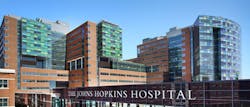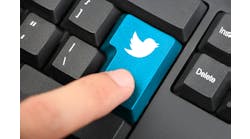Johns Hopkins Medicine’s Innovative Telemonitoring Solution Development Meets COVID-19
As the COVID-19 pandemic has swept across the U.S. and the world, healthcare leaders have been working hard to innovate around how to optimally manage the care of COVID-19 patients and monitor their conditions. In that context, leaders at the Baltimore-based Johns Hopkins Medicine have been working with emocha Health, whose telemedicine app that tracks the way patients take medicine and was previously used to track Ebola patients in 2015, to implement a system to monitor the health of first responders, doctors, nurses and caregivers battling COVID-19 on the frontline. In fact, emocha was initially developed at Johns Hopkins, during the time when clinicians there were preparing for the potential arrival of patients in U.S. hospitals who would be carrying the Ebola virus.
Recently, Healthcare Innovation Editor-in-Chief Mark Hagland interviewed Bob Bollinger, M.D., a professor of infectious diseases at Johns Hopkins Medicine in Baltimore, and Sebastian Seiguer, CEO of the Baltimore-based emocha Health, regarding this innovative work, and how clinicians at Hopkins have been able to leverage the technology to improve care management and monitoring.
Dr. Bollinger explains the origins of the technology as follows: “I’m a Hopkins faculty member, and it was a Hopkins invention that was eventually licensed out. We developed it in Uganda in 2007 and it’s now being used in the U.S. at Hopkins. A number of years ago, emocha was focused on leveraging this technology as a medication adherence technology, and also to directly observe therapies. A number of years ago with the outbreak of Ebola in West Africa, emocha worked with states and others to develop symptom-monitoring in the States, and that led to the development of biocontainment unit at Hopkins; there are a number of those, including in Nebraska. So originally, they were thinking about Ebola. This solution was developed to support that unit and its teams. So when COVID-19 emerged, Hopkins reached out to emocha about expanding this to other healthcare workers and other parts of the institution. And this is really a way to help employees to remotely monitor themselves for symptoms. It’s not just for hospitals and for doctors and nurses; remote monitoring and self-monitoring are important for EMTs, police, firefighters, food service, all sorts of people who are at risk for exposure. You also have to do it in a way that optimizes safety for everyone. And the technology helps us optimize the timing of these data collections.”
Per the core technological platform, Seiguer explains that “The technology was invented at Hopkins in 2008, as a research data collection platform. I met Dr. Bollinger in 2013,” he continues. “Dr. Bollinger and his team of infectious disease experts were very public health-focused, and just needed someone to commercialize the technology” that they had been developing.
In that context, he says, “When Ebola hit in 2013, the state of Maryland asked us to use the software for travelers coming into Maryland from four West African nations. And Hopkins had set up a biocontainment unit in case an infected person arrived in the United States, that they would go to Hopkins. And because Ebola is highly infectious—with a 40-percent death rate—they decided that any worker going into that unit needed to be monitored for signs and symptoms. At the time, the standard of care for Ebola was a temperature check in person. And nurses would have to go to their homes. And obviously, with Ebola, you couldn’t do that. The video check-in captures a self-video recording of someone taking their own temperature and showing the thermometer to the camera.”
In that context, Seiguer explains of the technology, “It’s being used to monitor healthcare workers for 14 days if they’ve been exposed. And in some cases, the number of exposures is too high. So in cases, you’ll monitor an entire group, to see if symptoms or temperature present. Most people don’t have temperature-based symptoms.” In terms of the mechanics involved, he explains, “We have an algorithm that will trigger a video check-in if certain symptoms are entered. If there are no symptoms and the temperature is under 100, it’s a non-video check-in-in. However, if they do have symptoms or a temperature, we’ll mechanically ask them if they have a fever or symptoms first. If yes, the camera goes on and they take their temperature, and just to be sure, they input the temperature, so we have a verification on video and we have an entry. And in the case of an actual COVID-19 patient, public health departments that are tasked with the monitoring of COVID-19-positive patients, some are using this software. In the case of the hospital, we are the ones monitoring the HC workers, and pass concerning cases back to employee health, and pass rosters back to them, of employees who are no longer symptomatic or who are problem-free.”
So how has this played out in terms of care delivery and care management at Johns Hopkins? “From a high-level view, we’ve been focused on sorting through perhaps three big issues,” Bollinger reports. “One is to reduce the probability that a particular person is infectious to others in the workplace. So are there policies and procedures we can implement to support that? An obvious example is that we’re doing more telemedicine consults, not only outpatient, but even inpatient, inside the hospital, to reduce the use of PPE and the likelihood of infection. The other is to reduce the likelihood that anyone will be exposed to an infected person, and become infected. We also want to estimate the likelihood that an employee is likely to become seriously ill if they become exposed.”
Looking at COVID-19 infection issues more broadly
Like their colleagues across the healthcare system, Dr. Bollinger and his team have been monitoring the COVID-19 pandemic very closely since it first emerged. Asked whether COVID-19 is a particularly challenging disease in terms of its rate of infectiousness, Bollinger says, “Yes, it is that, and it is also that the disease has a high mortality rate. This is our third coronavirus epidemic in 20 years, following SARS and MERS. The other two were and are deadly diseases, but this one seems to be much more infectious and is spreading more quickly. And it appears that this subgroup of viruses has modified a protein on their surface that makes them particularly sticky to receptors in the human respiratory tract, so that’s one factor. The other element is that we’re seeing these hyper-spreading events in nursing home facilities and even healthcare settings, and some of that is driven by the stickiness; but also, by the fact that people are spreading this for a day or two before they develop symptoms.”
What’s more, Bollinger notes, “When we first started seeing cases in New York City and Baltimore, they were happening before we even realized what was happening. Now we’ve put in physical distancing policies in place. And those of us in the infectious diseases area in particular—and Tony Fauci has been speaking about this for years—the thing that kept him up at night was a highly infectious respiratory disease. This is the global pandemic nightmare scenario that we’ve all worried about. The lethality of it is becoming clear; it’s more lethal among every age group than influenza.”
What about the challenges of applying technologies and care strategies in the present moment? “All of this has been extremely intense,” Seiguer says. “One of the challenges is that we don’t live in a culture where government policy is able to be pushed very successfully into the general public; we also have many states, and every state is like its own country and sets its own policies; whereas the nations that were very successful in handling COVID were very heavy-handed in setting policy. So Hopkins, or LifeBridge or Cedars-Sinai, their policy determines the diligence of the employees in participating. We’ve always been monitoring medication adherence, and we always want a 90-something-percentage reliance on the use of the technology.”
Still, Seiguer says, “We’re always reliant on policy. And strong policies will be helpful in keeping it tamped down. The other thing is that we used to only focus on patients who needed a lot of help—people with diabetes or asthma uncontrolled, for example, or an infectious disease. Now, we’re starting to manage people who aren’t already defined as positive. So emocha is now being distributed to thousands of different individuals/employees at a time. So how you roll this out to so many people and manage large amounts of digital data and input, that’s different; typically, digital health has not been disturbed en masse, in general.”
The PPE shortage crisis
What about the crisis around personal protective equipment (PPE) availability? “That remains a major challenge,” Bollinger says. “It’s an issue not just for healthcare workers in the hospital and in clinical settings, but for EMTs and others on the front lines. They need the supplies. One of our sons is an EMT in Chicago, and they’re having to reuse their N-95 masks. It’s not just an issue in the hospitals. And part of it is the supply chain issue and a lack of preparedness, not having enough reserves in place. But states and other organizations are working on that as quickly as we can. Hydrogen peroxide gas, etc., for sterilization, and we’re switching to a washable gown now at Hopkins. Look at all the incredible efforts to create face shields. So we’re doing the best we can, but it really highlights some challenges that existed before this, and the surge capacity that we need for the future.”
Back to the question of technologies that can help facilitate better patient and healthcare staffer monitoring and compliance, Bollinger says, “The things that I think about and have thought about are, if you’re able to help employees and first responders self-monitor for symptoms, it can provide them for more rapid linkage to diagnosis. And earlier diagnosis of healthcare workers can protect their families, co-workers, and others, by plugging them into diagnostic services. And earlier diagnosis of HC workers leads to early detection of outbreaks in the healthcare setting. And earlier linkage also helps them not only become diagnosed, but individuals can monitor their symptoms earlier and link them to earlier treatment and support services, as healthcare workers are themselves patients. And this can help to determine resource decisions.”
So what have the biggest lessons been learned in all of this work so far? “Sebastian has been behind the day-to-day; I’m the consultant coming at this from the clinical side,” Bollinger says of Seiguer. “But I think one of the things that we’re learning is that not every healthcare employee—and I suppose this is probably a lesson for telemedicine in general—that not everybody’s comfortable with technology; and not everybody has access to a smartphone, or even a thermometer. So to leverage the value of these remote-monitoring solutions, we have to look at the disparities in communities. The other element is that systems like this can detect symptoms and link individuals almost immediately by phone to people who can link them to care.”


